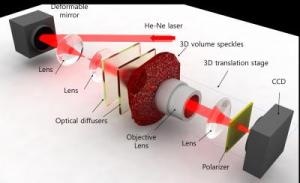Jan 30 2017
 The optical set-up consists of a deformable mirror and the scattering medium with two successive holographic diffusers. A high-numerical-aperture imaging unit mounted on a three-axis motorized translational system is utilized for wavefront optimization and imaging. CREDIT: KAIST.
The optical set-up consists of a deformable mirror and the scattering medium with two successive holographic diffusers. A high-numerical-aperture imaging unit mounted on a three-axis motorized translational system is utilized for wavefront optimization and imaging. CREDIT: KAIST.
Three-dimensional (3D) digital holograms have many prospective applications. In addition to arts and entertainment, this technology can also be beneficial in different fields such as displays, scientific visualization, engineering design, and biomedical imaging.
For instance, developing full-sized organs that can be used by doctors for 3D analysis can be useful; however, the limitations of hologram-generation methods create a major challenge to realize this.
Professor YongKeun Park from the Department of Physics at the Korea Advanced Institute of Science and Technology (KAIST) headed a group of researchers to find a solution to this challenge. Consequently, the team has created a 3D holographic display with the ability to perform over 2600 times more efficiently than the existing ones.
It is anticipated that the research will improve the viewing angle and limited size of 3D images, the main challenge posed by prevalent holographic displays. The study has been published online in the 23rd January issue of Nature Photonics.
3D holograms that are normally shown in science fiction films are very familiar to people; however, holograms exhibited in movies are developed using computer graphic effects. Techniques for developing real 3D holograms are still under analysis in laboratories.
For instance, owing to the complications in creating real 3D images, two disparate two-dimensional (2D) images are projected onto a viewer by the latest virtual reality (VR) and augmented reality (AR) devices to induce optical illusions.
For a 3D hologram to be viewed without the need for any special equipment (e.g. 3D glasses), the wavefront of light has to be controlled by employing wavefront modulators, which are optical manipulation devices with the ability to control the direction of light propagation. Deformable mirrors (DMs) and spatial light modulators (SLMs) are examples of wavefront modulators.
Yet, the number of pixels is the major setback in employing the wavefront modulators as 3D displays. The increased number of pixels packed into high-resolution displays created in the recent past is appropriate for a 2D image. Additionally, a 3D image cannot be generated using the amount of information contained in those pixels. So, generating a 3D image with a narrow viewing angle of 3° and a size of 1 cm using prevalent wavefront modulator technology is unfeasible.
In order to overcome this, the research team from KAIST used a DM including two additional successive holographic diffusers, as a substitute, to scatter light. The scattering of light in numerous directions ensures wider viewing angle and larger image. However, it results in volume speckle fields generated due to the interference of multiple rays of scattered light. 3D images cannot be displayed using random volume speckle fields.
To fix the problem, a wavefront-shaping technique was used by the researchers to control the fields. Consequently, the team successfully generated an enhanced 3D holographic image at a viewing angle of 35° within a volume of 2 cm of length, height, and width. The outcome was a performance that was almost 2600 times powerful than the original image definition produced using a DM without a diffuser.
Scattering light has previously been believed to interfere with the recognition of objects, but we have demonstrated that current 3D displays can be improved significantly with an increased viewing angle and image size by properly controlling the scattered light.
YongKeun Park, Professor, KAIST
According to Hyeonseung Yu, a doctoral candidate in the Department of Physics, KAIST, and the lead author of the research article, this technique is a valuable initiation in developing a practical model for producing dynamic 3D hologram displays that can be viewed and relished without requiring any special eyeglasses. “This approach can also be applied to AR and VR technology to enhance the image resolution and viewing angles,” further stated Yu.